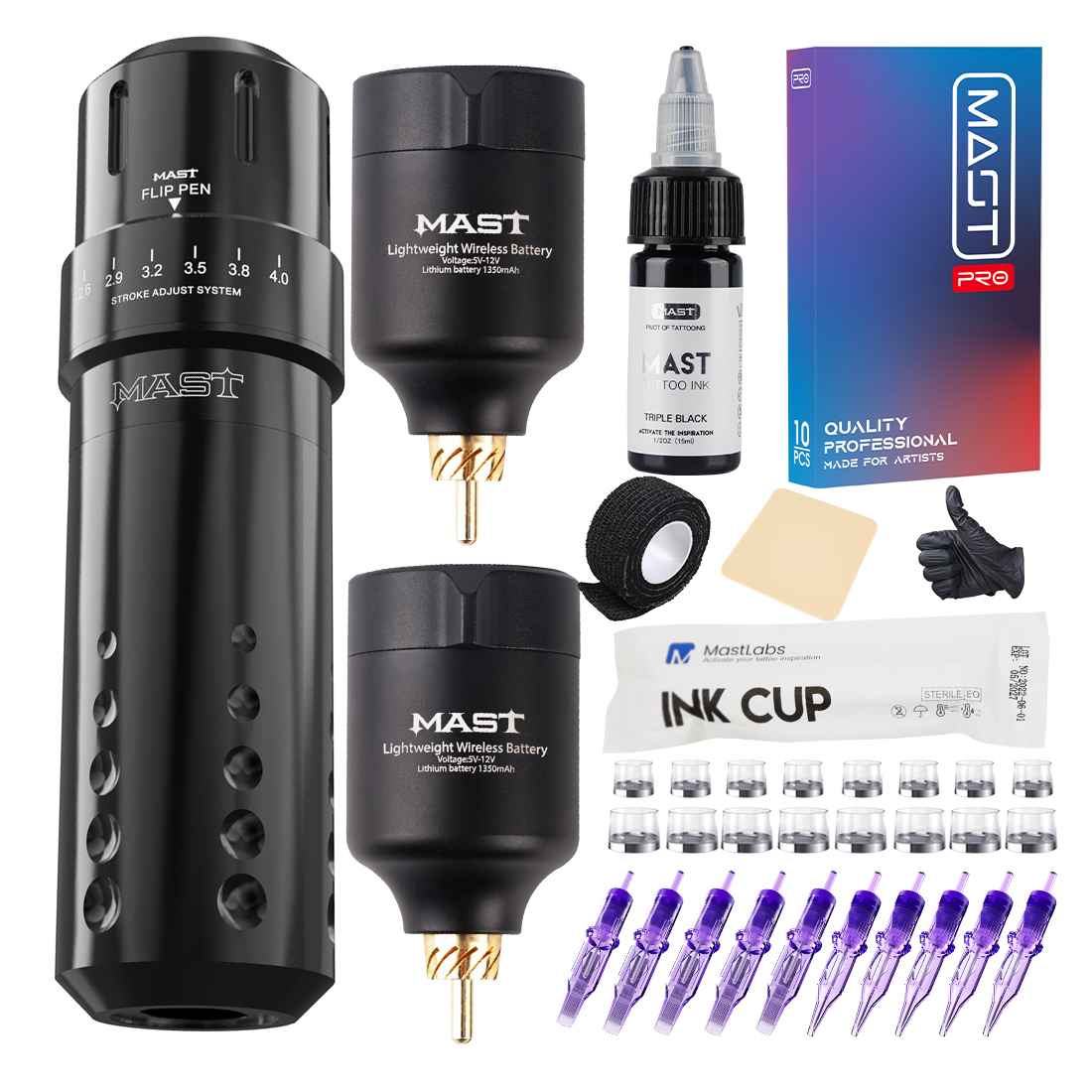Tattoos have been used for self-expression and art for centuries, with millions of people worldwide adorning their bodies with these permanent designs.
While the process of getting a tattoo is generally safe, there are potential risks and complications that can arise.
One such concern is what happens if a tattoo needle hits a vein during the process.
In this article, we will explore the effects of this occurrence, the risks involved, how to recognize it, and what steps can be taken to address the situation.
So, what happens if a tattoo needle hits a vein? Let’s find out
Understanding Tattooing Process
Before delving into the consequences of a tattoo needle hitting a vein, it’s important to understand the tattooing process itself.
A tattoo machine consists of a needle attached to a tube, which is powered by an electric motor.
The needle rapidly punctures the skin, depositing ink beneath the epidermis into the dermis layer, where it remains permanently.
Importance of Needle Depth
During the tattooing process, the depth at which the needle penetrates the skin is crucial.
The ideal depth allows the ink to be deposited in the dermis without reaching blood vessels.
Tattoo artists are trained to maintain consistent needle depth to avoid complications such as hitting veins.
Also Read: Can You Tattoo over Veins on Hand?
Risks and Complications of Hitting a Vein
When a tattoo needle hits a vein, several risks and complications can arise.
It’s important to be aware of these potential consequences before getting a tattoo to understand the importance of choosing a skilled artist and maintaining proper aftercare.
– Increased Bleeding
Hitting a vein during tattooing can lead to increased bleeding.
Veins are part of the body’s circulatory system, which transports blood throughout the body.
Damaging a vein can result in excessive bleeding during and after the tattooing process.
– Pain and Discomfort
Hitting a vein can cause additional pain and discomfort during the tattooing process.
Veins are more sensitive than surrounding tissues, and their irritation can intensify the sensation experienced by the individual receiving the tattoo.
– Allergic Reactions
In some cases, individuals may develop allergic reactions when a tattoo needle hits a vein.
The body’s immune system can react to the foreign substances present in the ink or other tattooing materials, leading to symptoms such as redness, itching, and swelling.
– Infection Risk
If a tattoo needle inadvertently pierces a vein, there is an increased risk of infection.
Bloodborne pathogens can contaminate the tattoo ink, leading to the potential transmission of diseases such as hepatitis B, hepatitis C, or HIV.
– Spreading Bloodborne Diseases
If a tattoo needle contaminated with bloodborne pathogens enters a vein, it can serve as a direct pathway for these diseases to enter the bloodstream.
This poses a serious health risk, emphasizing the importance of maintaining strict hygiene and infection control practices in tattoo studios.
– Potential Damage to Veins
Hitting a vein with a tattoo needle can potentially cause damage to the vein itself.
The needle may puncture or tear the vein, leading to further complications such as blood clots, bruising, or even long-term damage to the vein structure.
Also Read: Do tattoos make it harder to find veins?
Recognizing When a Vein is Hit
It is essential to recognize the signs that a vein has been hit during the tattooing process.
While tattoo artists should be vigilant in preventing such incidents, individuals should also be aware of the following indicators:
– Visible Blood
If a vein is hit, it is likely to result in visible bleeding. The presence of blood during the tattooing process should alert both the artist and the individual getting the tattoo to the possibility of a vein being compromised.
– Changes in Tattoo Appearance
When a vein is hit, it can affect the appearance of the tattoo. The ink may spread or blur due to the blood mixing with the pigment. This can result in a less defined or distorted tattoo design.
– Pain and Swelling
Hitting a vein can cause increased pain and swelling in the tattooed area. The individual may experience discomfort that exceeds the typical level associated with the tattooing process.
Immediate Actions
If it is suspected that a vein has been hit during a tattooing session, immediate actions can help minimize potential complications.
The following steps should be taken:
– Applying Pressure
Applying firm pressure to the area can help control bleeding if a vein has been hit. Clean cloth or sterile gauze should be used to avoid introducing additional contaminants.
– Elevating the Area
Raising the tattooed area above the heart level can help reduce bleeding and swelling. This can be achieved by keeping the limb elevated or using cushions or pillows for support.
– Seeking Medical Attention
It is crucial to seek medical attention if a vein is hit during a tattoo session. Healthcare professionals can assess the situation, provide appropriate care, and help prevent further complications.
Also Read: Can You Tattoo Over Bulging Veins?
Treating Complications
After a tattoo needle hits a vein, several complications may arise, and proper treatment is necessary to minimize their impact.
The following actions should be taken:
– Monitoring for Infection
Due to the increased risk of infection, close monitoring of the tattooed area is essential.
Signs of infection, such as excessive redness, swelling, or pus formation, should be promptly addressed by a healthcare professional.
– Addressing Allergic Reactions
If an allergic reaction occurs, medical attention should be sought. Depending on the severity, antihistamines or corticosteroids may be prescribed to alleviate symptoms and reduce inflammation.
– Bloodborne Disease Testing
In cases where contamination is suspected, bloodborne disease testing should be performed.
Testing for hepatitis B, hepatitis C, and HIV can help detect any potential infections early on, allowing for appropriate medical intervention.
– Vein Damage Evaluation
If there are concerns about potential vein damage, further evaluation may be necessary.
Doppler ultrasound or other imaging techniques can help assess the condition of the veins and determine if any additional treatment is required.
Also Read: Can tattoo cause infection? Find out
Preventing Vein Hits
Prevention is key when it comes to avoiding the complications associated with hitting a vein during tattooing.
To minimize the risk, the following measures should be considered:
– Proper Tattooing Technique
Tattoo artists should receive comprehensive training on proper technique, including needle depth control and avoiding veins.
Regular skill refinement and staying updated with industry best practices are vital.
– Knowledgeable and Skilled Tattoo Artists
Choose a tattoo artist who is knowledgeable and experienced. Research their portfolio, read reviews, and ensure they have a solid reputation for safety and quality work.
– Communication with the Artist
Effective communication with the tattoo artist is essential. Discuss any concerns or medical conditions that may increase the risk of complications.
A skilled artist will be attentive to such information and take appropriate precautions.
– Research and Choose a Reputable Tattoo Studio
Before getting a tattoo, research various tattoo studios in the area.
Look for establishments with a clean and hygienic environment, licensed artists, and adherence to proper sterilization procedures. A reputable studio prioritizes client safety.
Also Read: Can a Tattoo Needle Hit a Vein?
Conclusion
In this article, we’ve explored the question, “What happens if a tattoo needle hits a vein?” and I’ve given tips on avoiding such an occurrence and how to handle such a scenario in case it happens.
While hitting a vein with a tattoo needle is a potential complication, it is important to remember that with proper precautions and skilled tattoo artists, the risks can be significantly minimized.
If a vein is hit during the tattooing process, recognizing the signs and taking immediate action can help reduce the likelihood of complications.
By prioritizing hygiene, communication, and artist selection, individuals can enjoy the art of tattooing with peace of mind.
FAQs
Can hitting a vein during a tattoo session be life-threatening?
While hitting a vein during a tattoo session carries risks, immediate medical attention and proper care can usually prevent life-threatening complications. However, it is crucial to address the situation promptly.
Will hitting a vein affect the final appearance of the tattoo?
Hitting a vein can potentially affect the appearance of the tattoo. The ink may spread or blur due to the presence of blood, resulting in a less defined or distorted design.
Can a tattoo artist feel if they hit a vein during the process?
Experienced tattoo artists can often feel when the needle hits a vein due to the resistance and feedback they receive.
However, it is always crucial for both the artist and the individual getting the tattoo to remain vigilant and communicate any concerns.
How can I choose a reputable tattoo artist and studio?
Research various tattoo artists and studios in your area.
Look for online reviews, and portfolios of their work, and ensure they adhere to strict hygiene and sterilization practices.
Don’t hesitate to ask questions and communicate your concerns before making a decision.
Can a vein hit during a tattooing session cause long-term damage?
In some cases, hitting a vein during a tattoo session can lead to long-term damage to the vein structure.
This may result in complications such as blood clots, bruising, or compromised blood flow.
It is important to seek appropriate medical evaluation and care if there are concerns about vein damage.






